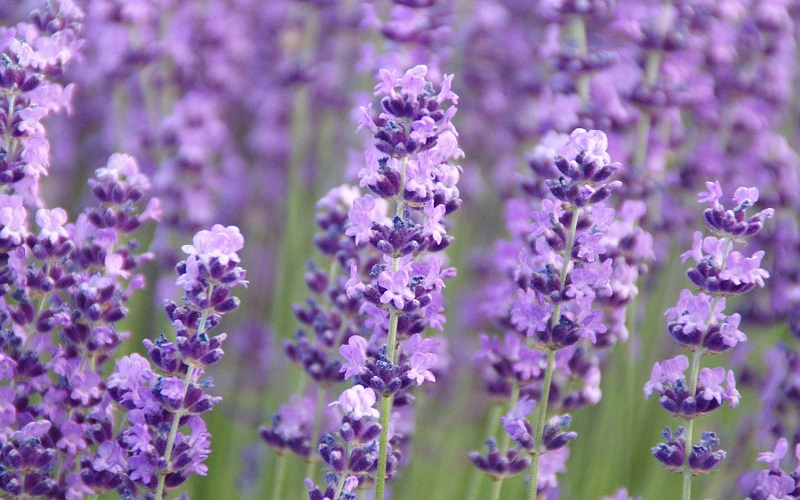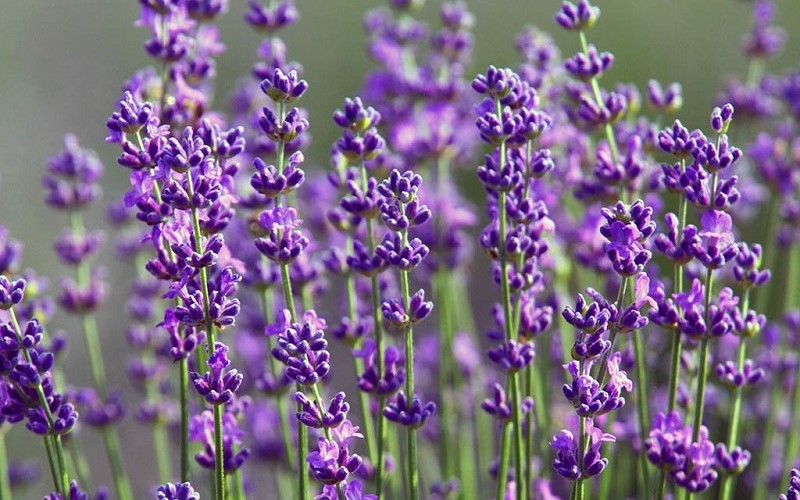Lavender is a beloved flower admired for its beautiful appearance and the profound messages it conveys. Let’s explore the legend, significance, cultivation, care, and uses of this enchanting flower!
1 Introduction to Lavender
Lavender, also known as Lavender originates from the Mediterranean and belongs to the genus Lavandula. This flower typically grows in bushes and has a distinctive strong fragrance, making it beloved by almost everyone.
Later, the Romans spread this flower throughout Europe, including Southern France, which is now the largest lavender-growing region in the world.
 There are numerous lavender fields in Southern France
There are numerous lavender fields in Southern France
2 Types of Lavender and Their Characteristics
With the advancement of biotechnology, approximately 47 different types of lavender have been discovered worldwide. However, the three most common and popular species are true lavender, spike lavender, and lavendin.
True Lavender
This species has green leaves, ranging from 2-6cm in length and 4-6mm in width. Its stems are slender and can grow to a height of 40-100cm. True lavender flowers are purple, oval-shaped, and grow in long clusters. The fragrance is sweet and pleasant.
 True Lavender
True Lavender
Spike Lavender
This species has coarse and large leaves, measuring 3-6cm in length and 6-10mm in width. Its stems are long and slightly slender, reaching heights of 50-120cm. Spike lavender flowers grow in clusters at the top of the stem and are light purple in color, with a fragrance reminiscent of a combination of camphor and lavender.
 Spike Lavender
Spike Lavender
Lavendin
This species has long, slender leaves, and sturdy stems that can grow to a height of 60-150cm. Lavendin flowers are greenish-purple, usually growing long and evenly spaced, with a stronger and more intense fragrance than the previous two types.
 Lavendin
Lavendin
3 Significance of Lavender
Legend has it that lavender was considered the “panacea” of ancient love. Even today, lavender remains a timeless symbol of romantic, faithful, understanding, and compassionate love.
Its significance goes beyond romance, as lavender also represents good luck. Therefore, people often gift dried lavender branches, wishing the recipient peace, luck, and success in their endeavors. It is also believed to bring luck to expectant mothers.
Lastly, lavender symbolizes the loyalty and closeness of friendship.
 Lavender conveys luck and friendship
Lavender conveys luck and friendship
4 Uses of Lavender
Beyond its delicate beauty, lavender offers a multitude of surprising benefits for health and daily life. Let’s explore the advantages of this exquisite flower!
Lavender essential oil effectively repels flies, mosquitoes, and other harmful insects. Therefore, you can use lavender oil not only to fragrance your home but also to keep these pests away from your family.
Lavender is a familiar ingredient in the production of perfumes, soaps, shampoos, and skin creams…
Lavender tea is excellent for stabilizing the nervous system and blood pressure. Consult your doctor about drinking lavender tea regularly as a possible alternative to medication.
The scent of dried lavender flowers can promote a calm and relaxed state of mind, reducing stress and anxiety.
Lavender is used as an effective antiseptic for wounds.
Lavender is a highly fire-resistant plant, making it ideal for planting on apartment balconies or as garden landscaping.
 Lavender essential oil has numerous uses
Lavender essential oil has numerous uses
5 How to Grow and Care for Lavender
Growing Lavender at Home
The easiest way to grow lavender at home is by planting seeds. You can easily find lavender seeds at reputable plant shops at affordable prices and start your own lavender garden.
However, the best time to plant lavender is during autumn and winter, as it thrives in cooler temperatures, optimally between 18-24 degrees Celsius. Therefore, in places with naturally cooler climates like Da Lat and Sa Pa, you can plant lavender any time of the year, while in hotter regions like the South, it’s best to wait until the end of the year.
Next, prepare the right type of soil. Lavender prefers well-drained, slightly sandy soil that is not too moist. Choose a sandy soil mix and a pot with ample drainage holes.
Finally, it’s time to sow the seeds. You must “wake up” the seeds before planting by soaking them in water for about 12 hours. Then, sow the seeds in the soil, spray with water to moisten, and cover with a thin layer of soil, approximately 0.2cm. Lastly, cover with a layer of grass or straw to maintain moisture in the pot.
Caring for Lavender
Water 2-3 times a week in the early morning and cool afternoons when the air temperature is mild.
Provide shade to minimize direct sunlight on the plant.
Fertilize only once a year in early spring, as lavender will flourish if the soil is already nutrient-rich.
Prune wilted branches to stimulate new growth and ensure sufficient nutrient supply for uniform and beautiful blooms.
How Long Does It Take for Lavender to Bloom?
Lavender usually blooms in June or July and continues blooming for 3-4 weeks.
 Growing and caring for lavender at home
Growing and caring for lavender at home
6 Where to Buy Lavender and Price Range
If you don’t have the time to grow and care for lavender, you can purchase high-quality French lavender from reputable flower shops near you. Additionally, e-commerce platforms like Shopee and Lazada are reliable sources for fresh or dried lavender based on reviews and feedback from previous buyers.
The price of lavender typically ranges from 300,000 to 1,000,000 VND per bundle, depending on the quantity and size. This is a reasonable price for a flower that exudes elegance, has a captivating fragrance, and lasts a long time.
We hope this article has provided you with comprehensive information about lavender. For those interested in learning more about this enchanting flower, we trust that this guide has been helpful.
16 Best Houseplants to Keep Mosquitoes Away
Having to deal with pesky insects such as flies and mosquitoes is something that most of us have probably experienced. Not only do these troublesome critters cause unsanitary spaces, they can also spread infectious diseases. While insecticides do the job, why not try something a little different and opt for plants to repel these insects while adding to the aesthetics of your home? Read on to learn more about the following plants that could help.






































